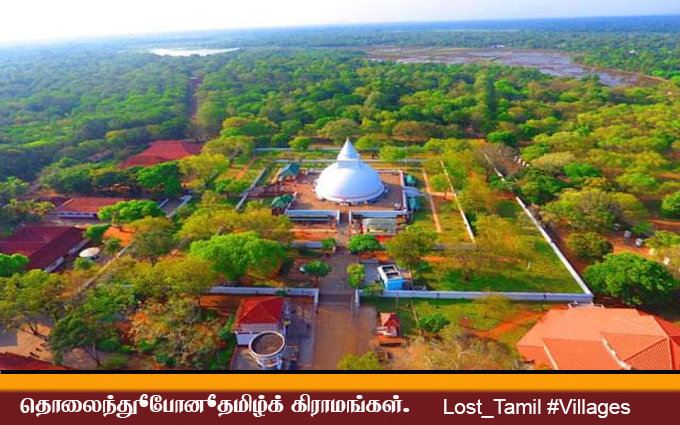

Lost_Tamil Villages.

A Study of Ancient Tamil Villages of Anuradhapura District- Part 1
A few years ago I conducted a survey in Anuradhapura district in search of traces of Shiva’s earth. At that time, the names of many villages in the district were a strain of Tamil names. I searched for details about these names because I was interested to explore them fully. As a result, a lot of surprising information was obtained. Anuradhapura district had many Tamil villages in ancient times. Temples were also built in all these villages. Over time the Tamil Saivites who were here left these villages and migrated to other places. The remaining Tamils intermarried with the Sinhalese. Today their descendants are seen as Sinhalese. In this case, the temples here have also decayed and perished without maintenance.
In some places where the Tamils lived, the Sinhalese Buddhists settled and built Buddhist monasteries near the places where the temples were, and worshiped the deities in the Hindu temples with great devotion. These temples are called “devalaya”. The Sinhalese Buddhist people worship the Hindu deities here as Gana Devi, Katharagama Devi, Ishwara Devi, Vishnu Devi, Kali Manion, Pathini Manion. Thus all Tamil villages became Sinhalese villages. At the same time, many temples were buried in the soil. There are many Tamil villages in this district which are still called by Sinhala names.
B.A. The Portuguese and Hollanders who came here from the 16th century destroyed hundreds of Hindu temples and some Buddhist monasteries from Sri Lanka with the aim of spreading their Christianity.
Priest Kwairos mentioned in his book that the Portuguese destroyed 500 temples in Jaffna alone. It is believed that up to 300 more temples may have been destroyed outside Jaffna in the North, East, North-West and North-East regions. These include temples in Anuradhapuram district.
All but a couple of temples destroyed by the Europeans in the northern and eastern regions have been identified and rebuilt during and after the British period. At the same time, the destroyed temples outside the north and east were not rebuilt. The reason for this is the absence of Tamil Saiva people there.
Robert Knox has mentioned in his book “An Historical Relation of Ceylon” about the concentration of Tamil people living in Anuradhapuram area in 1670.
Many such Tamil villages have been identified in Anuradhapuram district where Tamil people lived. Sinhalese people are currently living in these villages. The word “kulam” is found at the end of the names of these villages. Now these names have become a bit Sinhalese. It has been transformed into Nochik Kulam-Nochikulama, Kayan Kollai-Kayang Kolleva, Puliyangadavai-Puliangatavala and Maruthangallu-Marathangala. So these are identifiable.
On the other hand, the Tamil villages that have completely changed to Sinhalese names are unrecognizable today. For example the Tamil name of Puliyankulam has been changed to “Syambala Kasveva” and the Tamil name of Velangkulam has been renamed to “Divul Kasveva”. However, many villages that can still be identified as Tamil villages can be found in Anuradhapuram district.
There are a total of 21 Assistant Governor Divisions in this district. These include 694 Grama Sevakar units and 3085 villages. I identified 446 Tamil villages in these villages. After many days of research and great effort I found their Tamil names. This is a minimal amount. Because there are many unrecognizable Tamil villages.
I have arranged the names of the identified 446 Tamil villages according to the Deputy Governor’s Division. They are.
Mukhulai Assistant Governor Division-
53 villages.
Velankulam, Kattamankulam, Kalmadu, Chinna Sippikulam, Panichakkallu, Pudukulam, Chuchkulam, Periyakem Pikkulam, Narankulam, Mankulam, Mundripookkulam, Nochikkulam, Kammal Kulam, Kannathiti, Brahmin Fort, Ittikattu, Kasimadu, Kattambukhamum, Kaipitti, Vembukulam, Kunchikulam, Kurundankulam, Mannayam. Kulam, Sirukulam, Kulankulam, Mudalipankulam, Sangikulam, Alappankulam, Kalkulam, Karadikulam, Marudhankulam, Marudhankallu, Chinnakulam, Saippukallu, Chinnamarudhankulam, Marathankulam, Poovarasankulam, Pudukkulam, Nallapambukulam, Kurundankulam (Mikunthalai), Upper Karambankulam, Lower Karambankulam, Kayangulam, Kota Deer pond )
Nuvarakam Balatha Madhi-Assisted Govt Principal Unit –
60 villages.
Pasavakulam, Chinnapankuzhi, Kataikadu, Alangattu, Periyasenai, Otuppallam, Kalpalam, Samulangulam, Alankulam, Ettikulam, Pulyankulam (Aasirikama), Sambukulam, Bandara Pulyankulam, Pulyankulam, Kokuchi, Pinchukulam, Veerankuzhi, Karukankulam, Athikkulam (Cambrigasveva), Kalkulam, Itthikulam, Patarukulam , Kalkulam (Helampakasveva), Klumattukkadai, Nochikulam, Pondikulam, Pudukkulam, Vembukulam, Athikkulam, Alangakulam, Karambai, Karambaikulam, Maha Pulangkulam, Meloyamadu, Melathikkulam, Mel Puliyakulam, Steam, Echankulam, Periyapanguzhi, Perumian Kulam, Ilupukulam, Nellikulam, Pusiankulam, Koppakulam. Young , Thanayankulam, Andiyakulam, Teppan Kulam, Iluppan Gadavai, Ulukulam, Pulangakulam, Kallanji, Thirappanai, Melpulungulam, Nelungulam, Pandithankulam, Pandathankulam, Punchikulam, Thattan Kulam, Samulungulam, Madhuvacchi.
Kalneva Assistant Govt Principal Section-
9 villages.
Kallankudi, Kallanji, Kattarugamam, Karuvelamarakulam, Small Othappagam, Big Othappagam, Nagakamam, Pathinigamam, Verunkulam.
Horavabottana Assistant Govt Division –
14 villages.
Anaivilundhan, Tamilarkulam, Nimupbottanai, Chinnap Pulyankulam, Angunochi, Mukuvarkulam, Kayan Kollai, Parangiyarwadi, Pulyankadavai, Ratamalai, Mookkalansenai, Weeracholai, Madhuvacchi, Velankallu.
(more to come)
NKS Thiruchelvam
Historian
Sri Lanka